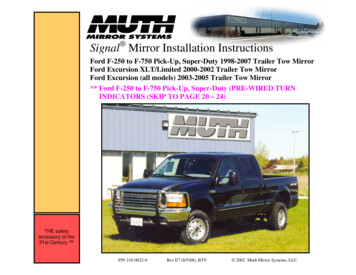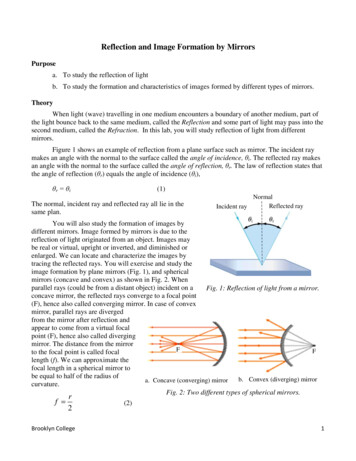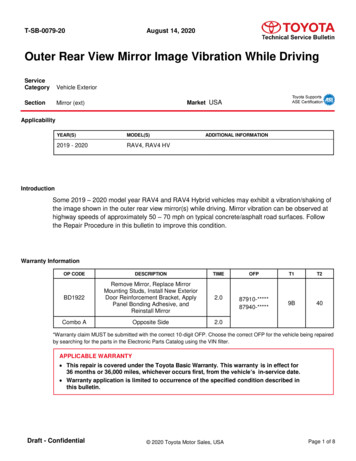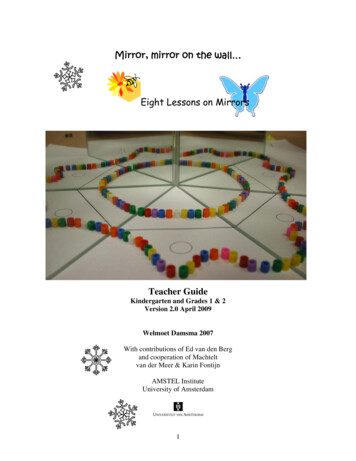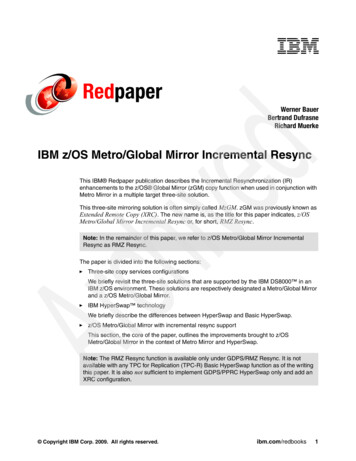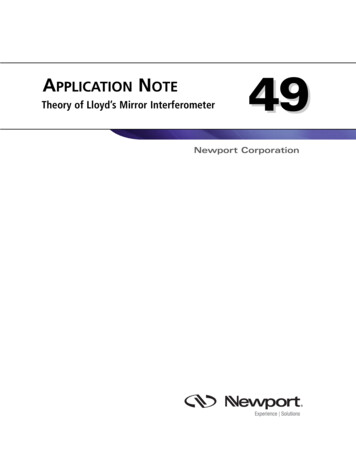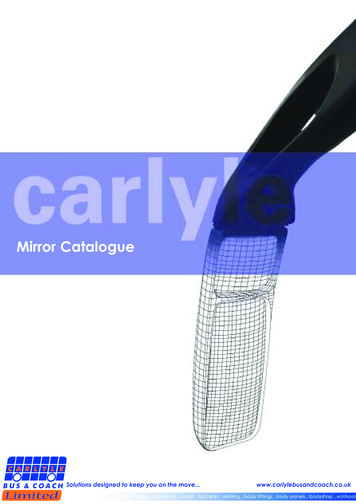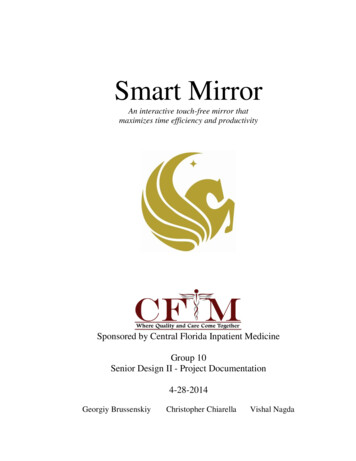
Transcription
Smart MirrorAn interactive touch-free mirror thatmaximizes time efficiency and productivitySponsored by Central Florida Inpatient MedicineGroup 10Senior Design II - Project Documentation4-28-2014Georgiy BrussenskiyChristopher ChiarellaVishal Nagda
Table of Contents1.0 Executive Summary.12.0 Project Description.22.1 Motivation.22.2 Goals and Objectives.22.3 Requirements and Specifications.32.3.1 PC Specifications.32.3.2 Necessary Features.42.3.3 Additional Features.43.0 Research related to Project Definition.53.1 Existing Similar Products and Projects.53.1.1 Projects.53.1.2 Products.63.2 Relevant Technologies.73.2.1 Gesture Control.73.2.2 Voice Control.93.2.3 Temperature Systems.93.2.4 HDD vs SSD.133.2.5 High Definition Display.153.2.6 Humidity Sensor.163.2.7 MCU.183.3 Strategic Components.193.3.1 Microcontroller.193.3.2 Leap Motion Controller.203.3.3 Webcam.223.3.4 Audio Capture.233.3.5 Control Computer.243.3.6 Temperature Control.253.3.7 Humidity Sensor.283.4 Possible Architectures and Related Diagrams.293.4.1 Compiler IDE.293.4.2 Code Libraries.304.0 Project Hardware and Software Design Details.334.1 Project Block Diagrams.334.1.1 Hardware Block Diagram.334.1.2 Software Block Diagram.344.2 Gesture Control Subsystem.344.2.1 Leap Motion Specifications.344.2.2 Supported Gestures.354.3 Temperature Regulation Subsystem.374.3.1 Microprocessor Specifications & Function.374.3.2 Temperature and Humidity Sensors.394.3.3 Temperature Restrictions.434.4 Webcam Subsystem.444.4.1 Webcam Specifications.44i
4.4.2 Motion Detection Design.444.4.3 Voice Recognition.474.5 Control Software Subsystem.484.5.1 Applications.484.5.2 Foreground and Background Task Processing.504.5.3 User Interface and GUI design.544.5.4 User Interface Gesture and Voice Controls.554.5.5 Microprocessor Software Overview.585.0 Design Summary of Hardware and Software.605.1 Hardware.605.2 Software.625.3 Housing.706.0 Project Prototype Construction.726.1 PC.726.1.1 Parts List.726.1.2 Parts Integration.736.2 Temperature Regulation System.746.2.1 Parts List.746.2.2 Assembly.746.3 Custom MCU.756.3.1 Parts List.756.3.2 Assembly.766.4 Housing.766.4.1 Parts List.766.4.2 Assembly.777.0 Project Prototype Testing.787.1 Hardware and Software.787.1.1 Unit Test – Temperature/Humidity Sensors.797.1.2 Unit Test – Microcontroller: Signal Control.797.1.3 Unit Test – Webcam: Motion Detection.807.1.4 Unit Test – Microphone: Voice Recognition.817.1.5 Unit Test – Leap Motion: Gesture Recognition.817.2 User Interface.827.2.1 Functional Test.827.2.2 Non Functional Test.847.3 Integration.857.3.1 System Test.858.0 Administrative Content.878.1 Milestone Discussion.878.2 Budget and Finance Discussion.889.0 Project Summary and Conclusions.90Appendix A – Copyright Permissions.91Appendix B – References.94ii
1.0 Executive SummaryEfficiency and productivity are two qualities that are increasingly establishing theirdominance as keywords companies are using to market their products. The fact that theirproduct can multitask or increase productivity better than the competition has become areal selling point. This is due to the fact that effective time management is an essentialfactor in increasing production of day-to-day life. The best time management strategiesinvolve being able to find time where there was no time before. Integration of technologyinto people’s daily lives has made that time management possible. The use of productssuch as tablets, PCs, and smartphones have given people access to the tools needed to beproductive.However, though successful technological products have been used to increaseproductivity, it has done its fair share to stifle it as well. The use of technology hasbecome another task on everyone’s daily to-do list. Technology should mold to ourschedule, not the other way around. That is where the smart mirror idea originated. Thesmart mirror idea aimed to integrate technology seamlessly into people’s lives by puttingit where everyone’s routine eventually collides, the bathroom. The goal of the smartmirror is to increase a user’s productivity by saving them time. The smart mirror providesa near effortless experience that allows the user to just walk up and be greeted withinformation they would typically need another device for. Despite the fact thisinformation can be found on the user’s other devices, it’s the time-saving convenience ofhaving this information available during the typical bathroom routines.The smart mirror has the necessary applications and features needed for time efficiencyfocused device. First, there is the easy on and off. The mirror automatically recognizesthat there is a user present and turns on the screen hidden behind the two-way mirror. Asuit of six applications are presented on the 32” high-definition screen surrounded by aframed encasing that contains speakers and a webcam. These apps include weather,Twitter, news, to-do list, calendar, and music. The smart mirror application is run from acentral computer with Windows 8.1 which features a multi-core CPU, solid-statememory, and wireless connectivity. The application can be interacted with by use of theLeap Motion controller. This controller allows for touch-free control of the smart mirrorby use of finger swipes, taps, and circles. There is also the option to use voice control toplay music, post a tweet, or add a task to the to-do list. Finally, the mirror monitors itsown temperature and humidity levels so that if the bathroom becomes potentially harmfulto the computer’s hardware, it can execute preventive measures and shut the systemdown.To develop a design of this size, significant research had to be done. First, similarprojects and products had to be investigated to what has been done and possibly whatneeds to be done. Next, the individual pieces of the mirror had to research in order todecide on the best product to use in the smart mirror system. Some of these topicsincluded the gesture control, voice recognition system, MCU, and hard drive type. Oncethe comparisons were made, each component was analyzed on how it will function withinthe system and what it has to offer.1
The design of the smart mirror was broken down into subsystems that represent importantcomponents of the project. Since there are hardware and software components to design,a block diagram was needed for both. The technical specifications were written for eachsubsystem for documentation and reference during the prototyping stage. The designcontained charts, state-diagrams, and circuit designs regarding the details relating to whatwas prototyped. Once completed, the smart mirror delivered the experience of technologybecoming part of a user’s routine and not an extra task.2.0 Project Description2.1 MotivationEffective time management is one of the most important factors for success andproductivity in a person’s day-to-day life. With the increasing integration of technologyin our lives, maintaining an efficient schedule has become both easier and more difficult.Keeping up to date with appointments, Twitter, news, social media, and other things ismade easier through technology such as tablets, PCs, and smartphones yet also providedistractions that can interrupt anyone’s routine. Technology has become another task inthe day that time must be allotted for. In the finite time of the day, technology needs to bedesigned to work within our schedule and not be an extra piece to it.The key to effective time management involving technology is multitasking. Anyone inthe business or academic world would agree that every second counts in the day. Thisproject was formulated through inspiration seen through movies such as Iron Man andtech demos, such as Samsung’s transparent LCD Smart Window, seen at the InternationalConsumer Electronics Show in 2012. This extends as well to the continuing trend ofintegrating touchscreens and internet-connectivity into everyday appliances such as ovensand refrigerators. The idea of a smart home is the direction lots of companies are headingand while the kitchen has been getting lots of attention, the bathroom has not. Besides thekitchen, the bathroom is one of the busiest rooms in the home, so it is an excellent placeto expand the smart home next.Constant information and instant access to it drive the current generation. Forgetbringing smartphones and tablets into the bathroom and risking damage. The smartmirror will show you that information with the swipe of a hand. The smart mirror is theresult of our team brainstorming on how to solve all these issues and develop somethingthat is functional as well as a showpiece.2.2 Goals and ObjectivesThe smart mirror must offer benefits of using modern technology while integratingseamlessly into the standard bathroom routines of most people. The smart mirror must besimple and as intuitive as possible. The smart mirror would be used to merge technologyand the need for information into anyone’s daily schedule. With the mirror in place, the2
user could interact and obtain the information they want during their normal morning andnight bathroom routines.This smart mirror aims to reduce and possibly eliminate the need for the user to maketime in their daily morning or nightly routine to check their PC, tablet, or smartphone forthe information they need. The mirror will provide the information with little to no effortfrom the user with the goal of not being a burden that he or she must maintain. Themirror wouldn’t be another activity, rather an enhancement to the already common use ofmirrors in most modern bathrooms.The mirror will do the thinking for the user. First, it will turn on and off by itself. Then, itwill update with the user’s calendar schedule, to-do lists, Twitter, news, and weather. Theinformation wouldn’t be thrown in the user’s face, but unobtrusively displayed on theedges of the mirror to still allow use of the actual mirror. The use of touch-less gestureswill keep things simple and easy to use. No keyboards to try to keep dry and clean. Thegestures will also allow the user to still use the mirror despite whether their hands are wetor dirty. The mirror provides common information most people check their smartphonesor tablets for, such as weather, news, Twitter and schedules. This allows the users to read,think, and plan their day while getting ready in the morning or night. The mirror has to befun as well. It will provide music playback that can be controlled by their voice so thereis no need for a mouse or keyboard.Finally, the mirror must be smart enough to protect itself from the wet and humidconditions that occur in every bathroom. It will feature a humidity protection systemwhere it will monitor the temperature and humidity levels near the hardware. If thetemperature or humidity levels are out of the safe operating range, then a failsafe systemwill notify the PC system so it can shut off to prevent damage.2.3 Requirements and SpecificationsThe smart mirror requirements and specifications took inspiration from people’severyday devices that they use including PCs, tablets, and smartphones. The mirrorintegrated similar features from each to give the user what they would expect out of amodern “smart” device. The following requirements and specifications were designed tosatisfy the goals and objectives discussed in the previous documentation section.2.3.1 PC SpecificationsThe smart mirror was run through a central computer that took in the data from thevarious sensors and peripherals which in turn were used to provide the user with its keyfunctionality. The general hardware specifications for this control computer are providedin Table 2.3.1.1 below.3
mini ITX Intel4GBIntel i364GB380 watt802.11b/g/nMotherboardRAMCPUSolid-State DrivePower SupplyWireless AdapterTable 2.3.1.1 – PC Hardware Specifications2.3.2 Necessary FeaturesThe “necessary” features were requirements that are imperative to the project’s designand objectives. They were designed and implemented before any additional features wereworked on. The necessary features range from hardware requirements to interactiveelements and to software elements. These necessary features are listed below. The smart mirror is designed to use a 32” diagonal display, positioned vertically,which will mounted behind a one-way mirror allowing only elements lit on thescreen to be seen by the user. The smart mirror is interacted by the user through the use of an infrared/cameracontroller called “Leap Motion”. This controller allows for touch-free multigesture recognition within an 8 cubic feet area above the controller. The smart mirror has a temperature and humidity monitoring system that willrelay data to the user as well as a failsafe system to keep the electronics protectedfrom water damage. The ideal operating range is 60 to 90 degrees Fahrenheit andbetween 20 to 80 percent humidity. The smart mirror contains speakers that allow for application notification soundsand music playback. The smart mirror user interface has a set of 7 standard applications that provideimportant information to the user including weather, Twitter, news, to-do list,calendar schedule, music, and clock. The smart mirror has an auto-on and auto-off system via use of a webcammounted in the housing. The mirror will turn on when it recognizes that there is auser standing in front of the mirror. The mirror will turn-off after 2-minutes of nouser present. The smart mirror has voice control through a voice recognition system developedinto the user interface. The voice control allows for interaction with the music, todo list, and twitter applications. The voice control is activated through a gestureprovided by the user.2.3.3 Additional FeaturesThe “additional” features were requirements that are less imperative to the overall designand function of the project but would add extra depth and usefulness to the smart mirror.These were to be designed only once all the necessary features were implemented andpolished to a suitable working state. These additional features are listed below.4
The smart mirror would make use of the digital zoom built into the webcam toprovide more facial detail to the user on the display. This would be equivalent to a10x zoom that could be used for putting on makeup or any other facial detailoriented task.The smart mirror would contain an outfit collection of the user’s favorite clothingcombinations. The user would take a photo of themselves in the outfit via thewebcam and it would be stored in a sudo-database. This sudo-database wouldthen be accessible to the user to identify what he/she wants to wear. Images couldbe displayed on one side of the screen to allow for direct comparisons to whateverthe user is currently wearing.3.0 Research related to Project Definition3.1 Existing Similar Products and ProjectsThe projects and products similar to our smart mirror project cover a large spectrum offunctionality and purposes. There were significantly more projects than actual products.Some blame can be put on the fact that the smart home is still an emerging market and islimited by the cost of manufacturing keeping the products out of reach from the everydayconsumer. The fact that there were more projects shows the interest in developing a moreaffordable and functional smart mirror. Although, the actual products developed by acompany delivered on features, they were either still in a development phase or alreadypriced too high to be considered a viable competitor.3.1.1 ProjectsThe following projects showed how the smart mirror can be designed in so many variousways. Each brought unique ideas and features to the term “smart”. Not all of theseprojects were designed and built in the same year, so there is a noticeable difference interms of use of available technology. Our smart mirror project has overlapping ideas witheach of these projects but none of them are exactly the same. The projects researched arefound below.Interactive mirror is a touch and gesture functional mirror created by Alpay Kasal andSam Ewen of Lit Studios [1]. The user touches the mirror, which has a built intouchscreen, to interactive with it. Unlike our smart mirror project, only one point oftouch is recognized because it is emulating a mouse. Also, this mirror is less about dataand more about artsy visuals. Users in the demo video show off different types ofdrawing and 2D games that are displayed using a projector. The fact that it emulates amouse is nice because of the expandability and the range of functions capable. Yet, thisstill differs from our smart mirror since it isn’t made to solve anything, only entertain.The HUD mirror was designed by five students for a course at the Chalmers Universityof Technology in Sweden [2]. They used a two-way mirror to allow the LEDs theymounted behind to illuminate information through the mirror similar to how the smart5
mirror will display information. This mirror was made for the bathroom and displayedtime, weather, outside temperature, and a toothbrush timer by use of the LEDs. Thetoothbrush timer is actually a useful feature that our smart mirror project should consider.Also, instead of using a touchscreen for interaction, they used light dependent resistors(LDRs) as buttons behind the mirror. When “touched”, the light changes and can performa function specified in the arduino software. Despite being simpler, the HUD mirror has alot of the same ideas as the smart mirror.The magic mirror was developed by the New York Times Research and DevelopmentLab [3]. It uses a TV with a mirror finish and uses a Microsoft Kinect to track movementand take in voice recognition. Also, it integrated a RFID reader to identify certainbathroom products. The whole system is run from a Windows PC just as the smart mirrorwill. The fact it can keep track of prescriptions and use the Kinect to “virtually” putclothes on the user are very inspiring features that given more time we’d love to integrateinto the smart mirror. The magic mirror also allows the ability to check email, calendars,and social media, which confirms that our smart mirror will offer features that users areexpecting.3.1.2 ProductsThe smart mirror is definitely not a true consumer product yet. There are very few trulymanufactured and ready for sale smart mirrors in the market. Those that are there are verydifferent in terms of functionality, development, and price. It is certainly going to take alarge smart home company to get behind this product and make it main stream to theconsumer. Each product did have a common feature, which was health management suchas weight. This is something our smart mirror doesn’t have a direct focus on and maybewould be something to change in the design if our project were to go public. Theproducts researched are found below.The android-powered mirror created by the Japanese company, Seraku, uses an androidtable to power the mirror [6]. An LCD monitor covered with a semitransparent reflectiveglass is used to make the mirror. The mirror contains apps such as weather, news, weight,temperature, and water flow. Water flow is an interesting addition and could be excellentin helping water conservation. The mirror also uses RF proximity sensors to interact withthe mirror with similar hands-free reasoning to why our smart mirror is using the LeapMotion controller. This mirror also comes paired with a scale, for analyzing and keepingtrack of the user’s weight. The product isn’t commercial ready so there is no estimate ofprice. A user’s health is definitely the marketing point to actually selling interactivemirrors, despite manufacturing costs probably holding them back.The Cybertecture Mirror is an actual product sold in Hong Kong [4]. It is made with amirror screen and uses a cable TV similar remote, or smartphone, to navigate itsapplications. The mirror is equipped with wifi, two stereo speakers, fog resistant glass,and parts designed to operate even under bathroom humidity. The interface containssimple apps that allow for different user profiles. Apps include weather, social media, TVprograms, virtual lighting, and health information. The health information is gathered6
through a scale that is paired with the mirror. This mirror is truly a design andengineering goal for our smart mirror. It contains almost all the features of the smartmirror plus some extra. Though, the virtual vanity lighting seems to lack the true functionof real lighting. Overall, an impressive mirror and shows that these type of mirrors arepossible. The only drawback is that the launch price was 7,733 which limits its adoptionin households to people who make a significant amount of money[5]. Our smart mirrorproject aims to be over 80% cheaper to produce.3.2 Relevant Technologies3.2.1 Gesture ControlOne of the most important decisions in the design was what to use for interaction with thesmart mirror since it directly influences the user and their experience. The elements inchoosing which gesture control system to use depend upon what the user was expected tointeract with on the screen. Also, the fact they are interacting with a mirror that ideallyshouldn’t need to be cleaned constantly because of finger prints. Option one for gesturecontrol was using infrared camera sensors to track position and movement of the user’shand. Option two was to use a controller-based peripheral like a TV remote to selectapplications on the screen. Option three was to use a capacitive touchscreen with a mirrorfinish to take gesture input on the screen.The use of infrared cameras and infrared lights is a common practice now for trackingmotion. Most security systems use passive infrared sensors in their products to detect thepresence of a person in the room or wherever the system is set up [9]. There are twopopular gesture controllers that involve use of infrared camera sensors to decode motion,the Microsoft Kinect and the Leap Motion Controller. The Kinect has an infrared-lightprojector that blasts infrared light into the space it is facing and then the reflections arepicked up by the infrared and RGB built-in cameras [8]. The Leap Motion is similar inthat it uses two infrared cameras that pick up the infrared reflections that the threeinfrared LEDs output onto the user [7].This use of IR cameras and IR emitters is visually demonstrated in Figure 3.2.1.1 below.The IR emitter covers the viewable area in infrared and then the IR camera collects thereflected infrared information. This data is then computed through vector analysis to getthe depth and coordinate information on the object [36]. The Kinect and Leap Motionfulfill the objectives for the smart mirror project by being an easy-to-use, hands-freeoption for controlling the mirror’s interface. The downside is that if the user is holding anobject, the system might get confused. Also, the sensors won’t work correctly if thecamera lens gets dirty or blocked by something that obstructs its view of the user’s hand.The final obstacle of using infrared light is that it can be interrupted by use of bathroomlighting that interferes with infrared light.7
Figure 3.2.1.1 – IR Camera and Emitter – Recreated with data provided from Maximum PCThe use of controller-based controls is a slightly less hands-free option than the infraredsensors but they are commonly less buggy and are fairly easy to use. Two popularcontroller options are the Wii Remote and PlayStation Move Controller. The Wii remoteuses an IR sensor bar and image s
The smart mirror must offer benefits of using modern technology while integrating seamlessly into the standard bathroom routines of most people. The smart mirror must be simple and as intuitive as possible. The smart mirror would be used to merge technology and the need for information into anyone's daily schedule.
